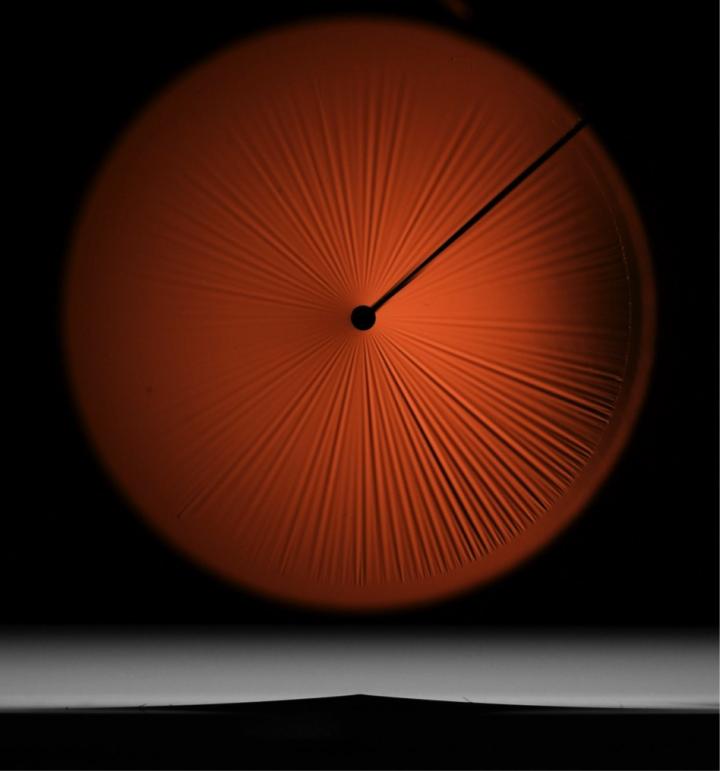UMass Amherst team offers new, simpler law of complex wrinkle patterns

A thin floating film is being poked from underneath. New arguments by researchers at UMass Amherst and Oxford University explain the observed wrinkle pattern. Credit: UMass Amherst/J.D. Paulsen
In a new paper, researchers at the University of Massachusetts Amherst and Oxford University describe a new, more general law for predicting the wavelength of complex wrinkle patterns, including those found on curved surfaces, plus experimental results to support it.
The work is expected to help materials scientists to use wrinkles to sculpt surface topography, or to use the wrinkles on surfaces to infer the properties of the underlying materials such as textiles and biological tissues.
Physicist Narayanan Menon points out that the work is crucial for understanding how wrinkle wavelength depends on properties of the sheet and the underlying liquid or solid. Findings appear this month in an early online issue of Proceedings of the National Academy of Sciences.
As he explains, “Wrinkles sometimes appear in nature in the form of regular, parallel corrugations such as the furrows on your forehead or the ripples formed when you blow on a cup of hot chocolate. Physicists understand the characteristic spacing between these wrinkles, known as the wrinkle wavelength, as a compromise between the thin skin, which resists being bent into a very fine pattern, and the underlying material, which resists bulging into a coarser pattern. But our understanding is limited to cases where the wrinkles are uniform, and laid out in parallel lines on a flat surface.”
He adds that, of course, most naturally occurring wrinkles do not satisfy these ideal situations. Most wrinkles in nature are more complicated; they often bend and splay, or are carried on a curved surface such as the outside of a cell, on a lens, an elbow or the bark of a tree.
The new law developed by a team including physicists Menon and Benny Davidovitch, with polymer scientist Thomas Russell at UMass Amherst and mathematician Dominic Vella of Oxford University, offers a scheme to quantitatively explain the wrinkle wavelength in more realistic situations.
The authors explain, “We propose a local law that incorporates both mechanical and geometrical effects on the spatial variation of wrinkle wavelength. Our experiments on thin polymer films provide strong evidence for its validity.” Menon adds, “A 'local' law explains the appearance of the wrinkles at a given location by the underlying properties of the materials at that location, without having to consider how these properties vary from place to place.”
###
Experiments conducted by former UMass Amherst postdoctoral researcher Joseph Paulsen, now at Syracuse University, and former graduate students Hunter King and Jiangshui Huang, establish the law's validity and point the way to further puzzles. The study was funded by a grant from the W.M. Keck Foundation.
Media Contact
All latest news from the category: Physics and Astronomy
This area deals with the fundamental laws and building blocks of nature and how they interact, the properties and the behavior of matter, and research into space and time and their structures.
innovations-report provides in-depth reports and articles on subjects such as astrophysics, laser technologies, nuclear, quantum, particle and solid-state physics, nanotechnologies, planetary research and findings (Mars, Venus) and developments related to the Hubble Telescope.
Newest articles

High-energy-density aqueous battery based on halogen multi-electron transfer
Traditional non-aqueous lithium-ion batteries have a high energy density, but their safety is compromised due to the flammable organic electrolytes they utilize. Aqueous batteries use water as the solvent for…

First-ever combined heart pump and pig kidney transplant
…gives new hope to patient with terminal illness. Surgeons at NYU Langone Health performed the first-ever combined mechanical heart pump and gene-edited pig kidney transplant surgery in a 54-year-old woman…

Biophysics: Testing how well biomarkers work
LMU researchers have developed a method to determine how reliably target proteins can be labeled using super-resolution fluorescence microscopy. Modern microscopy techniques make it possible to examine the inner workings…





















